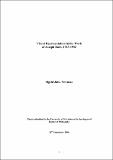Files in this item
Visual representation in the work of Joseph Roth, 1923-1932
Item metadata
| dc.contributor.advisor | Chambers, Helen | |
| dc.contributor.author | Newman, Sigrid J. | |
| dc.coverage.spatial | 227 | en |
| dc.date.accessioned | 2007-04-13T10:09:17Z | |
| dc.date.available | 2007-04-13T10:09:17Z | |
| dc.date.issued | 2007-06-22 | |
| dc.identifier.uri | https://hdl.handle.net/10023/317 | |
| dc.description.abstract | Through an examination of Joseph Roth’s reportage and fiction published between 1923 and 1932, this thesis seeks to provide a systematic analysis of a particular aspect of the author’s literary style, namely his use of sharply focused visual representations, which are termed Heuristic Visuals. Close textual analysis, supplemented by insights from reader-response theory, psychology, psycholinguistics and sociology illuminate the function of these visual representations. The thesis also seeks to discover whether there are significant differences and correspondences in the use of visual representations between the reportage and fiction genres. Roth believed that writers should be engagiert, and that the truth could only be arrived at through close observation of reality, not subordinated to theory. The research analyses the techniques by which Roth challenges his readers and encourages them to discover the truth for themselves. Three basic variants of Heuristic Visuals are identified, and their use in different contexts, including that of dialectical presentations, is explored. There is evidence of the use of different variants of Heuristic Visuals according to the respective rhetorical demands of particular thematic issues. It has also been possible to establish synchronic correspondences between the different genres, and diachronic correspondences within genres. Although there are examples within the reportage where the entire article is based on an Heuristic Visual, the use of Heuristic Visuals cannot be seen as a key organizing principle in Roth’s work as a whole. As his mastery of the technique reaches its highest point in the early 1930s, Heuristic Visuals are often incorporated into the reconstruction of a complete sensory experience. Analysis of Roth’s heuristic use of visual representations has led to important insights, including a reinterpretation of the endings of Roth’s two most famous novels: Hiob and Radetzkymarsch. | en |
| dc.format.extent | 864786 bytes | |
| dc.format.mimetype | application/pdf | |
| dc.language.iso | en | en |
| dc.publisher | University of St Andrews | |
| dc.rights | Creative Commons Attribution-NonCommercial-NoDerivs 3.0 Unported | |
| dc.rights.uri | http://creativecommons.org/licenses/by-nc-nd/3.0/ | |
| dc.subject | Joseph Roth | en |
| dc.subject | Visual representation | en |
| dc.subject.lcc | PT2635.O84Z5N88 | |
| dc.subject.lcsh | Roth, Joseph, 1894-1939--Criticism and interpretation | en |
| dc.subject.lcsh | Mimesis in literature | en |
| dc.subject.lcsh | Visual perception in literature | en |
| dc.title | Visual representation in the work of Joseph Roth, 1923-1932 | en |
| dc.type | Thesis | en |
| dc.type.qualificationlevel | Doctoral | en |
| dc.type.qualificationname | PhD Doctor of Philosophy | en |
| dc.publisher.institution | The University of St Andrews | en |
This item appears in the following Collection(s)
Except where otherwise noted within the work, this item's licence for re-use is described as Creative Commons Attribution-NonCommercial-NoDerivs 3.0 Unported
Items in the St Andrews Research Repository are protected by copyright, with all rights reserved, unless otherwise indicated.


